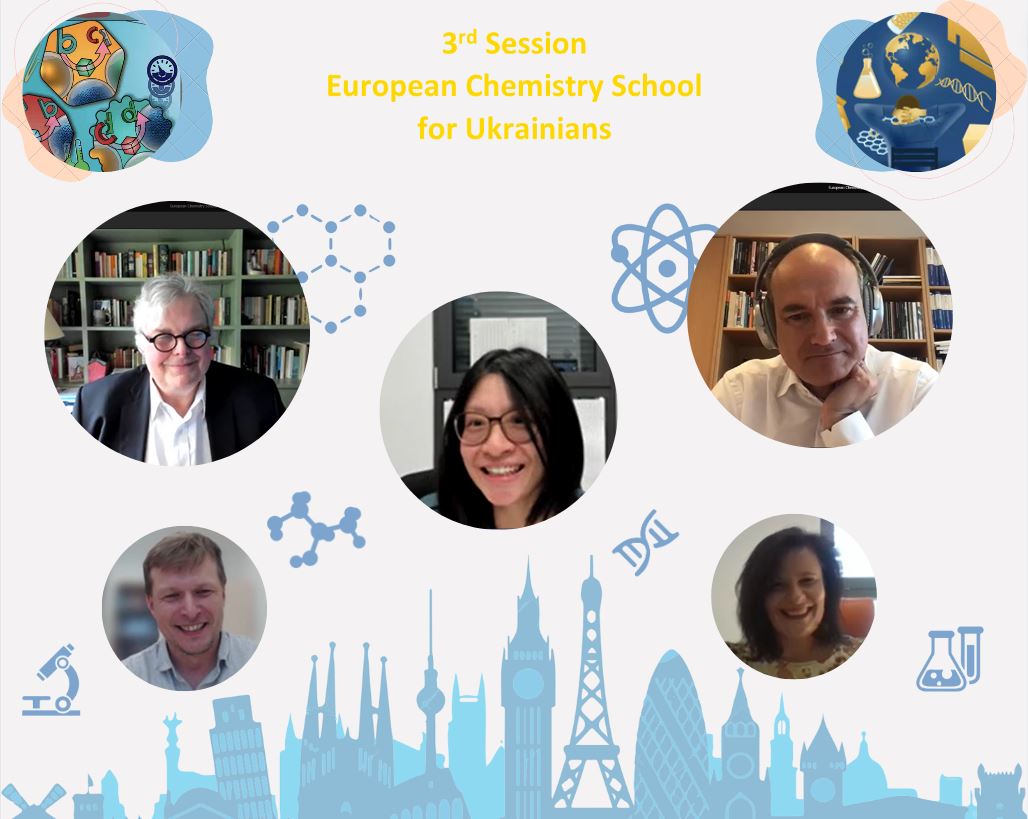European Chemistry School for Ukrainians
3rd Session June 1st 2023
Prof. Dr. Martin Schröder, Prof. Dr. Bert Weckhuysen, and Prof. Dr. Jia Min Chin roused the students of the European Chemistry School for Ukraine in the 3rd Session with tales of their work on Metal-Organic Frameworks (MOFs) and unique characterization methodology.
Prof. Dr. Martin Schröder of the University of Manchester did not begin his lecture with an overview of his scientific work – instead, he began with his name: Schröder. Although a popular surname in Germany, Schröder is uncommon in England. He explained that his parents were Estonian refugees who fled to Britain during World War II; like many of the Ukrainians in the audience, he and his own family intimately understand the effects of conflict.
The Schröder Lab studies the applications of MOFs in the selective capture of chemical species and catalysis of organic reactions. His research group has developed new series of MOFs designed to identify and selectively bind with many polluting gases such as methane, carbon dioxide, nitrogen dioxide, and even highly corrosive sulfur dioxide. His team has also optimized MOF catalysts for benzylic oxidation, carbon-carbon bond formation, and activation of carbon dioxide and methane. But the impressive abilities of the materials produced by the Schröder team only reflect half of the group’s expertise. Schröder’s group is also known for designing meticulous analytical experiments to characterize their complex frameworks, inventing instruments that continuously raise the standard of tools to monitor MOF performance.
Prof. Dr. Bert Weckhuysen of Utrecht University, described as a “detective” by his colleagues, spoke about his work on the development of techniques to monitor catalysis in real time using new spectro- and microscopic methods. Prof. Weckhuysen prepared a meta-analysis on the trends and outlook of physical chemistry in world facing climate crisis but armed with increasingly automated processes for scientific discovery. As he combed the literature for answers (or perhaps more accurately, inspiration) to share with the students of the school, Weckhuysen found that most experts in the field agree that the definition of chemistry needs to be broadened and its tools must be adapted to meet the needs of the public and private sectors – especially in the pursuit of maximizing resource efficiency.
Either fortuitously or through conscious foresight, Prof. Weckhuysen’s chosen field, catalysis, is at the root of establishing chemical efficiency. His team designs new, highly specialized materials to catalyze reactions useful in many fields, but especially in the energy sector. In their pursuits to fully understand the mechanisms of the process, the Weckhuysen team has developed a series of operando instruments that can monitor catalysis as it occurs. Weckhuysen shared some of their results, including the “ultimate movie of a catalyst at work”.
The final speaker of the day was Prof. Dr. Jia Min Chin of the University of Vienna, whose scientific work was presented within the story of her multinational career. After completing her doctorate in the United States at MIT, Prof. Chin was assigned to work on completely new materials at a Research Institute in Singapore. With no funding and limited manpower, she began tinkering with methods to replace lithography in the creation of highly ordered and controllable patterns at very small scales, and ultimately developed a system to perform “reverse breath figure patterning.” She then turned her sights to a new frontier, MOFs. Surrounded by a team of unashamedly curious high school students, Prof. Chin found herself one day in the lab with them playing with a delightful new material: liquid marbles. These structures, liquids encased in solids that exhibited signs of “superhydrophodicity” had a peculiar mixture of liquid and solid properties. The fun might have ended there (and her students might have passed a few days blending – literally- batches of hydrophobic powder and water to make the marbles) if she had not found inspiration during a particularly uninspiring meeting about cosmetics. While listening to a presentation about the development and commercialization of new sunscreens, Prof. Chin started thinking about adding a photo active element to her group’s liquid marbles… and was eventually able to add a UV trigger to the marbles, causing them to burst open under exposure to light.
After this (and some time spent finding ways to control the growth of MOFs inspired by grass, flowers, and fungi – resulting in a series of papers too detailed and diverse to recount here), the Chin research group finally landed on their current work – creating ordered structures of MOFs. Many MOF applications require these small anisotropic crystals to be aligned with one another. To respond to this need, the Chin team is developing methods to use magnetic and electric fields to line up crystals to make larger, hierarchically controlled superstructures that preserve the order of smaller particles as they are assembled to make macroscale frameworks, work that has already produced many promising methods and sparked collaborations with new partners around the world.
Written by Madeline Walden
Photo Collage by Orysia Zaremba



